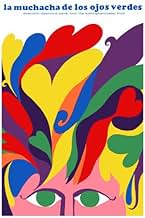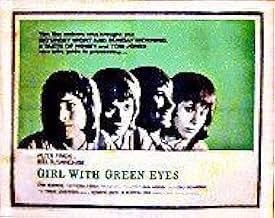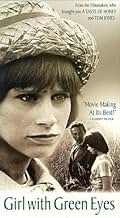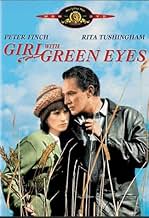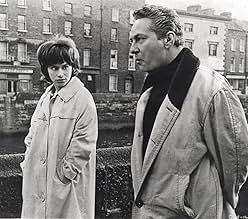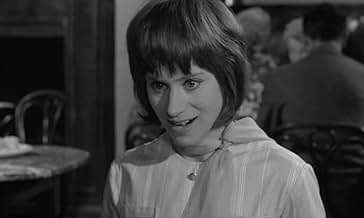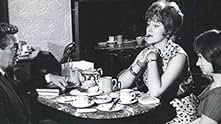VALUTAZIONE IMDb
6,9/10
1599
LA TUA VALUTAZIONE
Aggiungi una trama nella tua linguaIn 1960s Dublin a young girl becomes involved with an older man, a much-travelled and still-married landowner.In 1960s Dublin a young girl becomes involved with an older man, a much-travelled and still-married landowner.In 1960s Dublin a young girl becomes involved with an older man, a much-travelled and still-married landowner.
- Nominato ai 2 BAFTA Award
- 3 vittorie e 3 candidature totali
Marie Kean
- Josie Hannigan
- (as Maire Kean)
Liselotte Goettinger
- Joanna
- (as Lislott Goettinger)
Pat Laffan
- Bertie Counham
- (as Patrick Laffan)
Michael C. Hennessy
- Davey
- (as Michael Hennessy)
Joseph O'Donnell
- Patrick Devlin
- (as Joe O'Donnell)
Michael O'Brien
- The Lodger
- (as Micheal O'Briain)
David Kelly
- Ticket Collector
- (as Dave Kelly)
Recensioni in evidenza
It's just an episode but charmingly well done, Rita Tushingham shining with her eyes all through the film, well seconded by the slightly more reticent and laconic Peter Finch as the middle-aged writer with a failed family behind him and no illusions left, trying to be alone working by writing, which is difficult as Rita Tushingham keeps haunting him, and his family in America making themselves reminded by commenting on an aging man's relationship with a teenage girl with no experience - it could have been equivocal, but it isn't at all, since it is set in Ireland among angily bigotted catholics who also object against the unorthodox relationship and even try to do something about it by hard methods - there is some drama on the way. Lynn Redgrave assists Rita as well as she could and actually saves the situation in the end.
I saw this film when it was new, it was likeable enough already then, but made no lasting impression, wherefore I gave it a chance 50 years later just to refresh my memory and see what it really was all about - but it imported nothing new. It was still just an episode, charmingly well done, with the Rita's shining eyes and Peter's morose introversions - well done, indeed, but hardly universal, just local.
I saw this film when it was new, it was likeable enough already then, but made no lasting impression, wherefore I gave it a chance 50 years later just to refresh my memory and see what it really was all about - but it imported nothing new. It was still just an episode, charmingly well done, with the Rita's shining eyes and Peter's morose introversions - well done, indeed, but hardly universal, just local.
Rita Tushingham, the it girl of British cinema in the 60's (she made a few pics w/Richard Lester) stars as a young Irish lass who falls in love w/a separated writer played by Peter Finch. Shot in beautiful black & white on Irish locales, this sobering romance hits all the right notes when a love affair sounds good via the heart but makes no sense in the head. Look for Lynn Redgrave (Vanessa's sister) as Rita's roommate & Julian Glover, who's still acting strong (he played one of the maesters on Game of Thrones), as one of Finch's friends.
This film is based upon the second volume of Edna O'Brien's "Country Girls" trilogy. That novel was originally published as "The Lonely Girl", but for some reason this was changed in the film adaptation to "Girl with Green Eyes", even though it was made in black and white so one cannot tell what colour the main character's eyes are. Subsequent editions of the book were also entitled "Girl with Green Eyes".
The title character is Kathleen "Kate" Brady, a naive young girl from the rural west of Ireland, who moves to Dublin, where she works in a grocer's shop and shares a room with her friend and schoolmate, Barbara "Baba" Brennan. (Baba is only a secondary character in "Girl with Green Eyes", but she plays a more central role in the other two episodes of the trilogy). Kate hopes to find a boyfriend, but she is shy and naïve and has less success than the more worldly-wise Baba. Eventually, however, Kate becomes involved with the middle-aged Eugene Gaillard, and it is their romance which forms the main subject-matter of the film. (In the original novel Eugene was a film-maker, but here he becomes a writer).
The age difference between Kate and Eugene is not the only obstacle in the way of their relationship. She is a devout Catholic and he a freethinker who does not share her faith. To make matters worse, he is married with a child. He is separated from his wife, but the two are not formally divorced. (At the period when the film is set, divorce was not possible in the Irish Republic; Mrs Gaillard, an American by birth, has had to return to her native country in order to obtain one). Kate's widowed father is horrified by the idea that his daughter is involved with a married man and he descends on Dublin with a group of friends, virtually kidnapping Kate and forcing her to return home, although at the first opportunity she can get she runs back to Eugene.
When the "Country Girls" trilogy was first published, between 1960 and 1963, it caused great controversy in O'Brien's native Ireland. It could be published in Britain but was banned in the Republic, and copies of the books were publicly burned. (It seems that the only freedom the Irish people had gained by secession from the UK was the freedom to be less free than their neighbours). It is therefore surprising that permission was given to make the film in Dublin and other Irish locations, even though it was made in 1964, only a hear after the final instalment in the trilogy had come out.
The film was, however, made by a British production company, Woodfall Film Productions, and the leading actors were all either British (Rita Tushingham as Kate, Lynn Redgrave as Baba) or Australian (Peter Finch as Eugene). Despite the Irish setting, it was made in the "kitchen sink" social-realist style popular in Britain in the late fifties and sixties. Woodfall had earlier made other films in this style, such as "A Taste of Honey", which also starred Tushingham, and "The Loneliness of the Long Distance Runner", both directed by Tony Richardson, who acted as executive producer for "Girl with Green Eyes". The director, however, was Desmond Davis, making his directorial debut after working as a cameraman. .
At the time, the "kitchen sink" school was hailed as marking a new departure in British film-making, although the vogue for films of this nature was to be a relatively brief one, and did not really survive into the seventies (not, by any means, the most distinguished decade in British cinema history). "Spring and Port Wine" from 1970 can be seen as marking the end of the line. Nevertheless, that brief period saw some films of genuine quality and gave a voice to the British working class who had previously been neglected by the country's film-makers.
There are first-rate performances from Tushingham as Kate, a much more sensitive and vulnerable figure than her Jo in "A Taste of Honey", and from Finch as Eugene, a rather more sympathetic figure than he is in the book, a sophisticated, intellectual type who is at first flattered by the attentions of a younger woman, but who realises that the differences between them are too great to be easily overcome. "Girl with Green Eyes" is perhaps less well-known today than films like "Saturday Night and Sunday Morning", "A Taste of Honey" or "The Loneliness...", but I think it deserves to be better remembered.
The title character is Kathleen "Kate" Brady, a naive young girl from the rural west of Ireland, who moves to Dublin, where she works in a grocer's shop and shares a room with her friend and schoolmate, Barbara "Baba" Brennan. (Baba is only a secondary character in "Girl with Green Eyes", but she plays a more central role in the other two episodes of the trilogy). Kate hopes to find a boyfriend, but she is shy and naïve and has less success than the more worldly-wise Baba. Eventually, however, Kate becomes involved with the middle-aged Eugene Gaillard, and it is their romance which forms the main subject-matter of the film. (In the original novel Eugene was a film-maker, but here he becomes a writer).
The age difference between Kate and Eugene is not the only obstacle in the way of their relationship. She is a devout Catholic and he a freethinker who does not share her faith. To make matters worse, he is married with a child. He is separated from his wife, but the two are not formally divorced. (At the period when the film is set, divorce was not possible in the Irish Republic; Mrs Gaillard, an American by birth, has had to return to her native country in order to obtain one). Kate's widowed father is horrified by the idea that his daughter is involved with a married man and he descends on Dublin with a group of friends, virtually kidnapping Kate and forcing her to return home, although at the first opportunity she can get she runs back to Eugene.
When the "Country Girls" trilogy was first published, between 1960 and 1963, it caused great controversy in O'Brien's native Ireland. It could be published in Britain but was banned in the Republic, and copies of the books were publicly burned. (It seems that the only freedom the Irish people had gained by secession from the UK was the freedom to be less free than their neighbours). It is therefore surprising that permission was given to make the film in Dublin and other Irish locations, even though it was made in 1964, only a hear after the final instalment in the trilogy had come out.
The film was, however, made by a British production company, Woodfall Film Productions, and the leading actors were all either British (Rita Tushingham as Kate, Lynn Redgrave as Baba) or Australian (Peter Finch as Eugene). Despite the Irish setting, it was made in the "kitchen sink" social-realist style popular in Britain in the late fifties and sixties. Woodfall had earlier made other films in this style, such as "A Taste of Honey", which also starred Tushingham, and "The Loneliness of the Long Distance Runner", both directed by Tony Richardson, who acted as executive producer for "Girl with Green Eyes". The director, however, was Desmond Davis, making his directorial debut after working as a cameraman. .
At the time, the "kitchen sink" school was hailed as marking a new departure in British film-making, although the vogue for films of this nature was to be a relatively brief one, and did not really survive into the seventies (not, by any means, the most distinguished decade in British cinema history). "Spring and Port Wine" from 1970 can be seen as marking the end of the line. Nevertheless, that brief period saw some films of genuine quality and gave a voice to the British working class who had previously been neglected by the country's film-makers.
There are first-rate performances from Tushingham as Kate, a much more sensitive and vulnerable figure than her Jo in "A Taste of Honey", and from Finch as Eugene, a rather more sympathetic figure than he is in the book, a sophisticated, intellectual type who is at first flattered by the attentions of a younger woman, but who realises that the differences between them are too great to be easily overcome. "Girl with Green Eyes" is perhaps less well-known today than films like "Saturday Night and Sunday Morning", "A Taste of Honey" or "The Loneliness...", but I think it deserves to be better remembered.
This is a cute story about a young girl named Kate Brady, (Rita Tushingham) who lives with another girl named Baba Brenan, (Lynn Redgrave) and Baba sort of leads her roommate Kate around with her and is very talkative and has had plenty of relationships with men. However, Kate Brady becomes very interested in a man who is twice her age and begins to do everything she can to capture his attention. This man is Eugene Gaillard, (Peter Finch) who is a writer and a married man with a daughter and Eugene is not getting along very well with his wife and wants to get a divorce. Kate begins to get Eugene's full attention and before you know it, they are starting a strange relationship with each other which can lead to a great deal of trouble. Kate's family becomes involved and there are big problems facing Kate. This is a rather bitter sweet love story which is very true to what life is really all about. Enjoy.
Desmond Davis, who had worked closely with Tony Richardson, decided to try his hand directing films. For his first effort he decided to use Edna O'Brien's novella "The Lonely Girl", which we read a long while ago, and frankly, we don't remember it well. The result was a movie that has that "English Look" of what came out of England during those years.
"Girl with Green Eyes" owes its success to Rita Tushingham, an actress that was the darling of English movie makers. She had a certain waif look that she used to her advantage in films such as this one, and in others of the same period. She holds the movie together as it's hard to take one's eyes from hers. Ms. Tushingham was not a spectacular beauty, yet she had a certain look that was appealing in her work.
Peter Finch appears as Eugene Gaillard, a man who is divorced with a child, and whose estranged wife has moved overseas. His attraction for Kate Brennan is quite understandable, yet, Eugene can't get Kate to be more than a platonic admirer, never being able to consume the passion she feels for him, and vice versa.
Also in the movie, a young and fresh Lynn Redgrave, who went to make bigger and better things on her own in the British cinema and on the stage and films in America, her adoptive country.
"Girl with Green Eyes" is worth a look for what Desmond Davis was able to accomplish in his first feature. The copy we watched recently was sadly in need of restoration.
"Girl with Green Eyes" owes its success to Rita Tushingham, an actress that was the darling of English movie makers. She had a certain waif look that she used to her advantage in films such as this one, and in others of the same period. She holds the movie together as it's hard to take one's eyes from hers. Ms. Tushingham was not a spectacular beauty, yet she had a certain look that was appealing in her work.
Peter Finch appears as Eugene Gaillard, a man who is divorced with a child, and whose estranged wife has moved overseas. His attraction for Kate Brennan is quite understandable, yet, Eugene can't get Kate to be more than a platonic admirer, never being able to consume the passion she feels for him, and vice versa.
Also in the movie, a young and fresh Lynn Redgrave, who went to make bigger and better things on her own in the British cinema and on the stage and films in America, her adoptive country.
"Girl with Green Eyes" is worth a look for what Desmond Davis was able to accomplish in his first feature. The copy we watched recently was sadly in need of restoration.
Lo sapevi?
- QuizIn the montage of the girls getting ready for their dates near the movie's beginning, the 45 r.p.m. record is "Fell In Love On Monday" by Fats Domino, who is also the topic of the magazine article near the record.
- Citazioni
Malachi Sullivan: Ah, the milk of human blindness.
- ConnessioniFeatured in Talkies: Remembering Dora Bryan/Our Dora (2019)
I più visti
Accedi per valutare e creare un elenco di titoli salvati per ottenere consigli personalizzati
- How long is Girl with Green Eyes?Powered by Alexa
Dettagli
- Data di uscita
- Paese di origine
- Lingue
- Celebre anche come
- La muchacha de los ojos verdes
- Luoghi delle riprese
- Wellington Monument, Phoenix Park, Dublin, County Dublin, Irlanda(Kate & Eugene and later Kate & Baba go there)
- Azienda produttrice
- Vedi altri crediti dell’azienda su IMDbPro
Botteghino
- Budget
- 140.000 £ (previsto)
- Tempo di esecuzione1 ora 31 minuti
- Colore
- Proporzioni
- 1.66 : 1
Contribuisci a questa pagina
Suggerisci una modifica o aggiungi i contenuti mancanti

Divario superiore
By what name was La ragazza dagli occhi verdi (1964) officially released in India in English?
Rispondi

